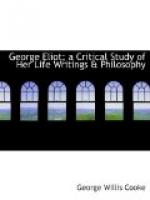George Eliot shows these two influences in antagonism with each other; on the one hand a reforming Christianity, on the other the renaissance movement. She admirably contrasts them in their spirit and influence, though she by no means indicates all of the tendencies of either. Her purpose is not that of the historical novelist, who wishes simply to give a correct and living picture of the time wherein he lays his plot. She vises this portion of history because it furnishes an excellent opportunity to unfold her ideas about life, rather than because it gives an abundance of picturesque material to the novelist. Her primary object is not the interpretation of Florentine life in the time of Savonarola; and this subordination of the historical material must be kept fully in mind by the reader or he will be misled in his judgment on the book. It has well been said that the historical characters in Romola are not so well sketched as the original creations. Savonarola is not so lifelike as Tito. She seems to have been cramped by the details of history; and she has not thoroughly conquered and marshalled subordinate to her thought the mass of local incidents she introduces. Her account of Savonarola is inadequate, because it does not enter fully enough into his history, and because it omits much which is necessary to a full understanding of the man and his influence.
So far as the book has an historical purpose it is that of describing the general life of the time rather than that of portraying Savonarola. Because of this purpose much is introduced into the story which is irrelevant to the plot itself. Not only did the author desire to contrast a man like Savonarola, led by the spirit of self-denial and renunciation, with one like Tito Melema led by the spirit of self-love and personal gratification; but she wished to contrast worldliness and spirituality, or individualism and altruism, as social forces. Lorenzo and the renaissance give one form of life, Savonarola and Christianity give another; and these two appear as affecting every class in society and every phase of the social order. To bring out this contrast requires a broad stage and many scenes. Much which seems quite irrelevant to the plot has its place in this larger purpose, and serves to bring out the final unity of impression which the author sought to produce. Nor is the purpose of the book merely that of contrasting two great phases of thought and of social influence, but rather to show them as permanent elements in human, nature and the nature of the effect which each produces.
Romola demands for its thorough appreciation that the reader shall have a considerable acquaintance with Italian history in the fifteenth century and with the social and literary changes of that period. Whether it is read with a keen interest and relish will much depend on this previous information. To the mere novel-reader it may seem dull and too much encumbered by uninteresting learning. To one who




